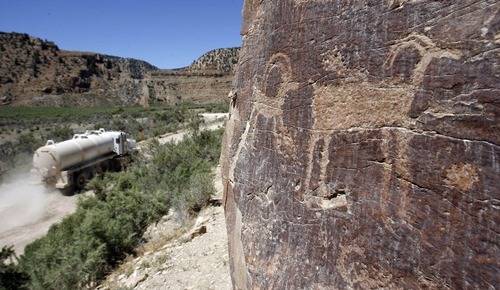This is an archived article that was published on sltrib.com in 2011, and information in the article may be outdated. It is provided only for personal research purposes and may not be reprinted.
Price • Paving the dirt road through Nine Mile Canyon may be the next step in a landmark agreement to drill nearby gas wells while protecting ancient rock art from dust — though it's one that some of the canyon's fans fear would change it forever.
Carbon County wants to own the portion of the canyon road managed by the U.S. Bureau of Land Management, and the county and the Bill Barrett Corp. hope to put a $20 million chip-seal surface on it to suppress dust from the gas field's truck traffic. The state would kick in $5 million, the company $10 million and Carbon and Duchesne counties $5 million for the road work.
"That's the answer: some kind of permanent cover to keep the dust down," said Ray Matheny, a retired archaeologist who has studied the canyon's petroglyphs and other sites for decades and once led Brigham Young University's field school there. Big trucks rumbling on the dirt road kick up dust that obscures and may damage the rock art, he said, even since the company agreed to apply a pitch-based suppressant when needed.
"It's just unacceptable," Matheny said of the dust.
Paving the old road, once a wagon path to Price and nearby ranches, is a solution some aren't sure would permanently protect the antiquities. Others fear it would make a speed zone of what once was a leisurely drive into prehistory.
"I just can't imagine people going fast on that road," said Westminster College anthropology professor Gretchen Siegler. She used to bring students on field trips to see some of the canyon's thousands of archaeological gems but has stopped because of the trucks. A hard surface would change the canyon's character further, she said, causing sightseers to zip in an out of major attractions instead of slowing trolling the road while searching for rock etchings that indicate good spots to explore by foot.
"It's just a remarkable thing that Price has," she said of the canyon's archaeology, "and the fact that they're in there and doing that kind of work is very unfortunate."
Connie Stewart, a Henefer resident who prizes the canyon and its Ute and Fremont Indian sites, said the industrial activity is ruining the place. The roadbed already encroaches on the archaeology, she said, and she doesn't see why more improvements are needed when the dust suppressant appears to work. "The future of Nine Mile Canyon scares me," she wrote in an e-mail. " I am sorry that it was 'discovered' when it couldn't be properly protected."
Bill Barrett Corp. agreed to terms approved by the Southern Utah Wilderness Alliance and many archaeologists to develop the nearby West Tavaputs Plateau while limiting the number of truck trips and suppressing dust. Gov. Gary Herbert frequently points to the deal as evidence that compromise can lead to responsible energy development.
The company has periodically spread a sticky substance that temporarily holds down the dust, although some archaeologists and rock-art lovers fear that once this gunk dries and gets airborne it can cause further damage to the petroglyphs. The next step would be a hard surface, and the BLM is taking public comments about that for another week. If approved, the project would stretch for 36 miles — 11 of it on federal land — and would include drainage culverts, concrete low-water crossings and asphalt on the sharpest curves, in addition to the chip-seal on most sections.
It's something Carbon County has long wanted, and not just for energy development. The pavement would help recreation access, including for deer and elk hunters, river runners heading to the Green and archaeological tourists, said Rex Sacco, the county's public lands director. He remembers getting stuck in the canyon when he was young and looks forward to the new convenience.
"There were times," he said, "you'd go down there and have to stay two or three days because of the mud."
County Commissioner John Jones said the road would protect the archaeological sites and make the already-popular canyon safer for tourists.
"There's never a time I go up there," Jones said, "when there's not three or four cars from out of state going out to look at the rock art."
BLM project archaeologist Julie Howard said up to five sites on the road's shoulders might be directly affected by road construction and require excavation and study. One such site near the road's end at Cottonwood Canyon is essentially a buried ancient trash heap, part of which could be removed and studied before the rest of the hillside is stabilized.
Area advocates for the canyon wish the BLM would consider a partial detour around the parts with the most archaeological sites. Some of the trucks reach the canyon by descending Gate Canyon from Duchesne County. It would be possible from there to reach at least parts of the gas field through a bypass across a smaller road down Trail Canyon — an option the county says would cost millions more.
"Maybe this is the next best thing," said Nine Mile Canyon Coalition Director Pam Miller, preferring a hard surface to stop the dust. It's unclear how chip-seal would hold up to trucks, though. "I just hope it works."
Her next great fear is the next gas development: Gasco's proposed field north of the canyon's rim, currently under BLM review. Dust from that project could ride thermal winds into Nine Mile Canyon, she said, undoing some of the pavement's benefit. —
Paving Nine Mile
I To comment to the BLM by the Friday deadline:
E-mail • UT_PR_Comments@blm.gov
Fax • 435-636-3657
Write • Bureau of Land Management, Attn: Connie Leschin, Price Field Office, 125 S. 600 West, Price, UT 84501





